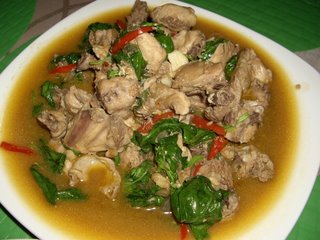
Presenting the ubiquitous Laing, which, like its equally famous sibling Bicol Express, has received several Tagalog versions. The Bicol Express as it is known hereabouts is just like Ginataang Baboy -- pork with a little sili. In Bicol, sili (siling pansigang or finger chili) is the main feature of Bicol Express and the pork bits are added just for flavoring.
The Tagalog version of Laing uses just the leaves of the gabi (taro), and is sometimes not even a bit spicy (example: Goldilocks Laing). The ingredients are minimal -- sometimes just the shredded taro leaves and coconut milk.
The authentic, Bicolano Laing uses the stalks as well and is made special by the addition of pork and fresh shrimp. The sili is "all you can" -- all you can put, all you can possibly take. :) The serving/presentation is just as special and detailed -- the laing mixture is wrapped in gabi leaves and topped with curdled coconut cream. Real laing is eaten not in spoonfuls but by the pinch -- because that's the only way you can stand the level of spice.
Don't worry though, for in this recipe I scaled down the spiciness to tolerable levels. But of course this won't be real Laing if it's not kick-ass maanghang.
Warning: If you're on a diet and need to avoid eating rice, READ NO FURTHER. :)
 LAING
LAINGWhat's In It?
5 bunches gabi leaves and stalks -- drier, better
2 large cans coconut cream, or 6 cups coconut cream (from 2 coconuts)
1/2 kilo pork liempo, diced
100 g. small shrimps, (alamang) fresh, not salted
3 teaspoons brown sugar (optional)
1 large onion, peeled and sliced finely
1 large knob of ginger, peeled and diced finely
5 cloves garlic, peeled and minced
6 pcs. finger chilies, sliced diagonally into thin rings
5 pcs. ripe siling labuyo
1/8 cup cooking oil
1 shrimp broth cube
1 pork broth cube
Kitchen Conjugations:
PREPS-- Cut the gabi leaves off from the stalks. Check for the largest and best leaves (those with the least tears or holes) and set them aside (you will need about 8 to 10). Shred the rest using your fingers or kitchen scissors. Set aside.
Cut off the prickly part of the stalks and discard. Carefully peel skin from the gabi stalks and set aside (for use in tying the wraps later). Dice the peeled stalks into bits, set aside.
MAKING THE FILLING -- In a deep frying pan or wok heat oil then saute onions, ginger and garlic for one minute. Add in pork and sliced chilies, stir frying for 3 minutes or until pork loses pink tint and is half cooked. Add in alamang, brown sugar (if using) and diced stalks. Stir fry for 2 minutes.
Pour in 2/3 cup of the coconut cream. Stir to combine. Reduce heat and let the simmer for 3 minutes or until the stalks are tender. Add the shredded gabi leaves and cook for 3 minutes more. Remove pan from fire when the leaves have wilted.
WRAPPING UP -- Put the whole gabi leaves on a flat surface. Spoon about 3 tablespoons of the cooked mixture over each leaf, avoiding any tears or holes. Fold the leaves into a square, making the edges overlap. Secure and tie each wrap with the gabi skin strips. Repeat until all the mixture has been wrapped.
COCO CREAM BATH -- In the same deep pan or wok, heat coconut cream, broth cubes and siling labuyo to a pre-boil. Squish siling labuyo to allow the spice to meld with the coconut cream. Simmer for half a minute then carefully add in laing wraps. Let boil and simmer until the coconut cream gets reduced to half of its original volume.
Serve with hot, steaming rice, fried galunggong or tilapia, and glasses of water. :)
 This is my entry to the 20th edition of Lasang Pinoy, which features wraps as a way of Filipino cooking and food presentation. Read more about the theme here.
This is my entry to the 20th edition of Lasang Pinoy, which features wraps as a way of Filipino cooking and food presentation. Read more about the theme here.


 Mike and I, we love seafood. As you (would) probably notice, most of the recipes (and food reviews) here (will) feature prawns, squid and fish.
Mike and I, we love seafood. As you (would) probably notice, most of the recipes (and food reviews) here (will) feature prawns, squid and fish.










